A while back, Uniqlo released a line of t-shirts and dresses inspired by The Tale of Genji. The prints are absolutely beautiful and I became really curious about whether there was any meaning about them. Since Uniqlo credited Unsodo for the designs, I emailed them to see if they could provide any insight.
According to Unsodo, the designs for The Tale of Genji were taken by Uniqlo designers from motifs in Unsodo prints that they felt were evocative of The Tale of Genji and arranged onto the clothing. In order words, the shirts aren’t a faithful reproduction of a print, but rather inspired by the prints. The company also recommended this book that they publish that has both prints and its explanations.
Once I knew that there was a book about these prints, I immediately ordered it (and it arrived within the week, which is amazing). I’ve been reading it for the past few weeks and marvelling at the details in this drawings. While I can’t find the exact motifs that the Uniqlo designers drew upon [1], I did see some similarities and I thought it would be fun to go through as many of the Uniqlo shirts as I can and talk about what they could mean. I’ll also talk about the contents of chapters of each print so that you can get a sense of what The Tale of Genji is all about.
Note: all the product images are from the Uniqlo website. Also, they don’t actually have names so I made some descriptive ones up. I’ll link to the their Uniqlo page and hopefully that still works even after the collection is finished.
Purple Plum Flower Shirt
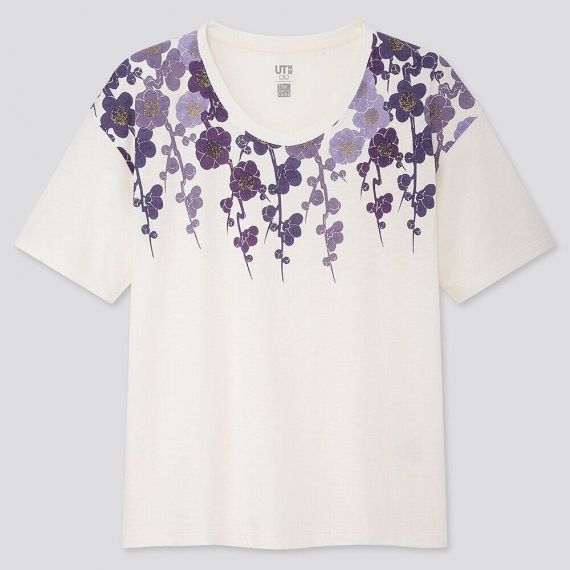
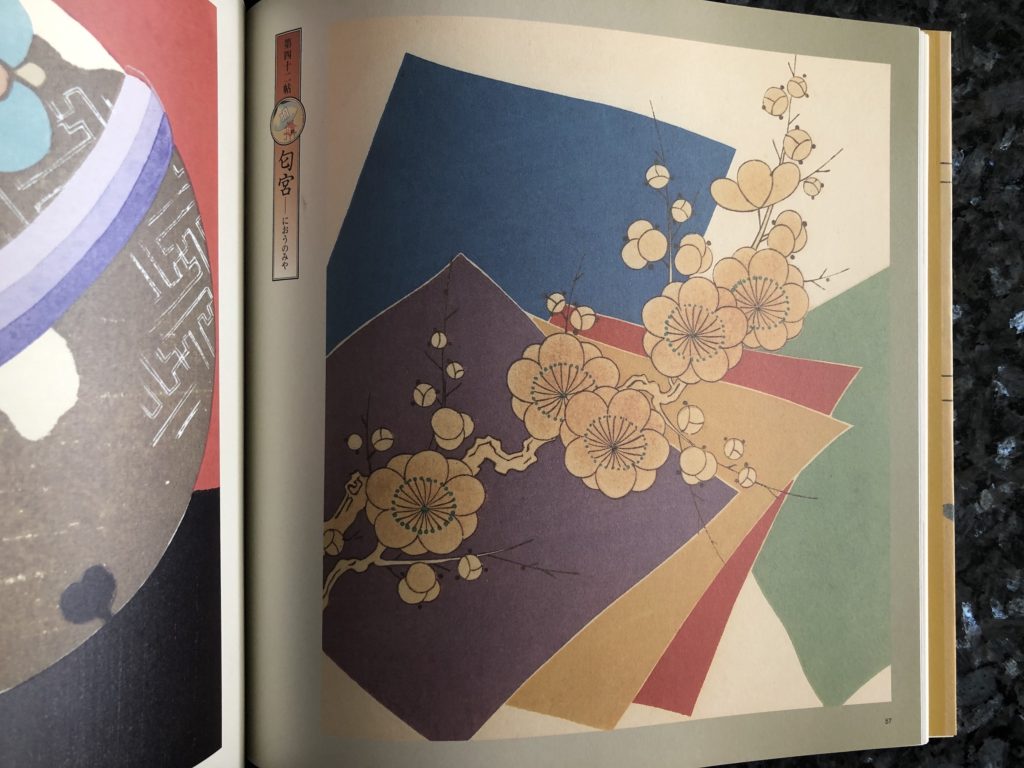
Print 42 
Print 43
There are some lovely plum flowers in the pictures in Print 42 (the purple paper is also very close to the colour of the plum flowers on the shirt) and Print 43.
Chapter Summaries: Chapter 42 is the first chapter after Genji has died (nine years after his death, in fact) and it introduces Kaoru, Genji’s supposed son (but actually not) and Niou (Genji’s grandson, since he is the son of the Emperor and the Princess Akashi). Both boys smell good [2].
In Chapter 43, titled 紅梅 (kobai; Rose Plum), To-no-Chujo’s son Kobai has become the head of the Fujiwara clan and is intent on marrying his daughters to the imperial family. He wants Niou to marry his second daughter and sends a page-boy (also his son) to Niou with a branch of rose plum. Unfortunately for Kobai, Niou is more attracted to his stepdaughter.
What this could mean: The flowers in Print 42 are the plum flowers at the Rokujo house, while the ones in Chapter 43 are the ones that To-no-Chujo sends to Niou. Given Niou and Kaoru’s association with scent, I think these flowers are about the two boys.
Fan with Flowers Shirt

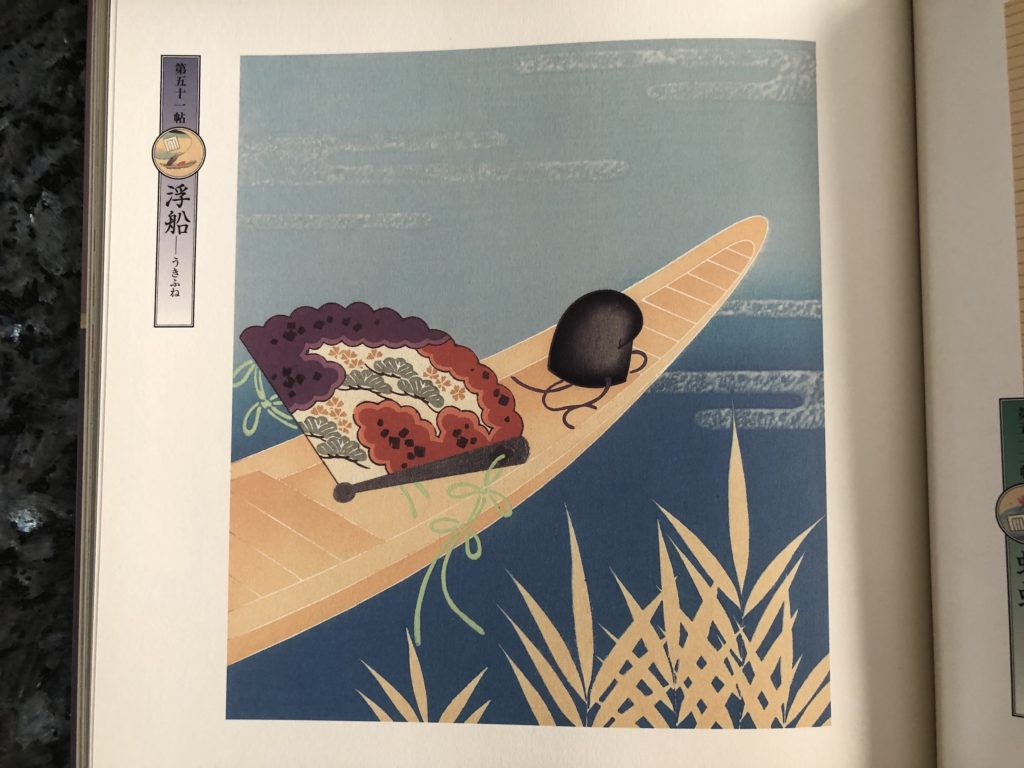
Print 51 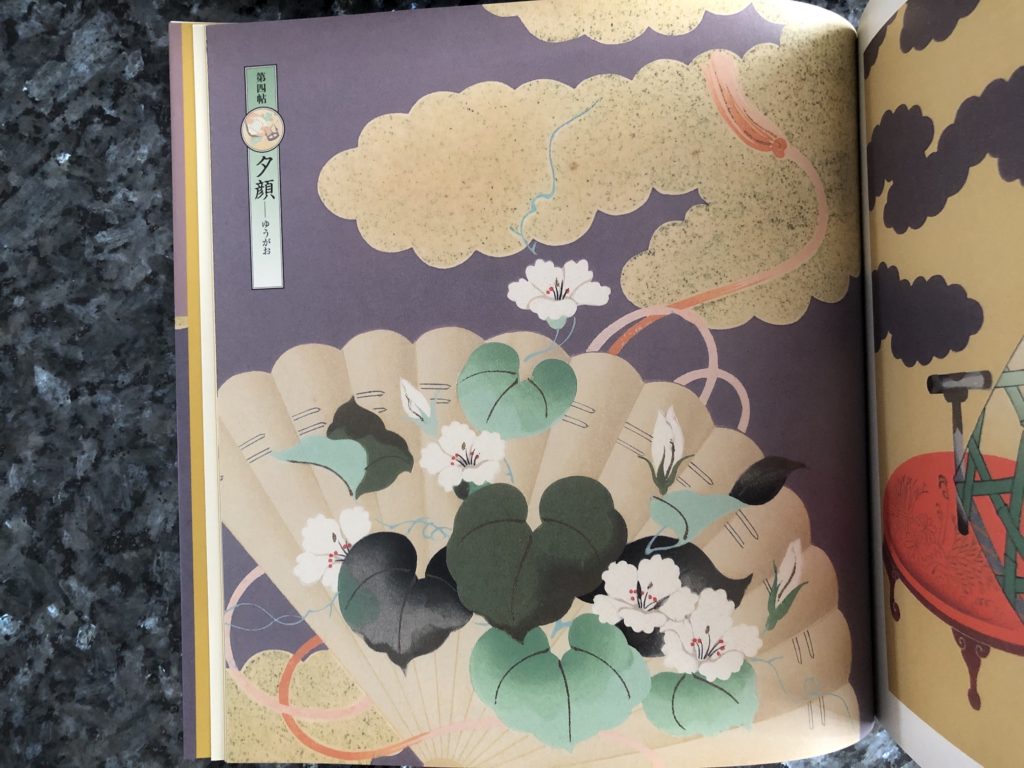
Print 4 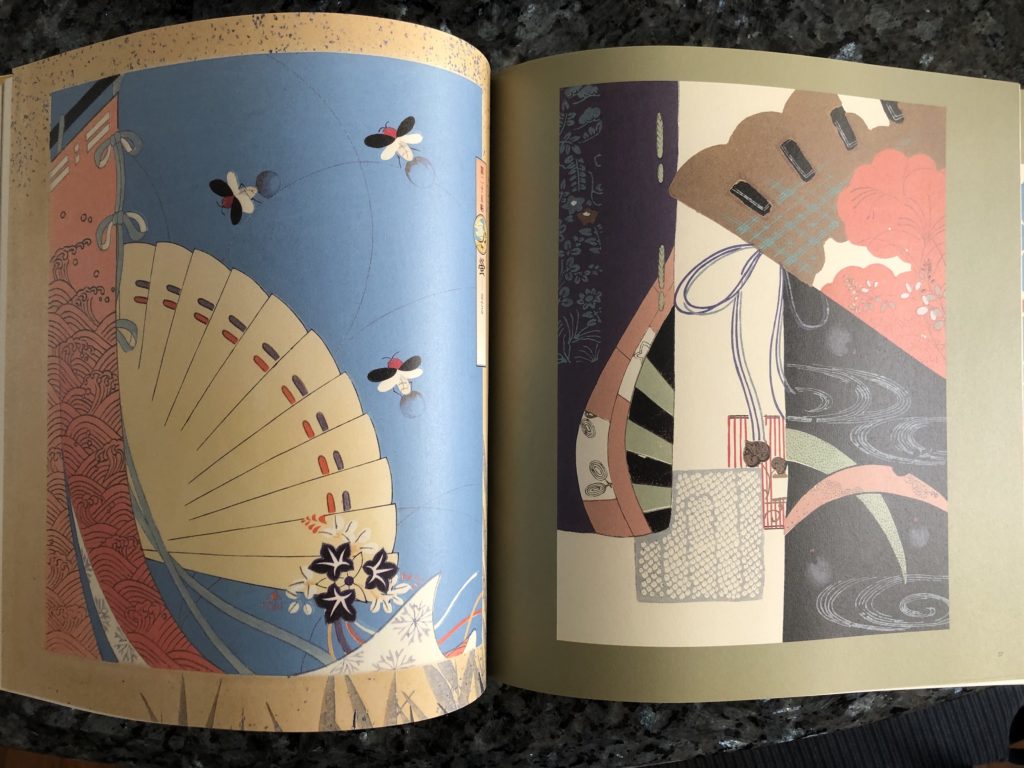
Print 25 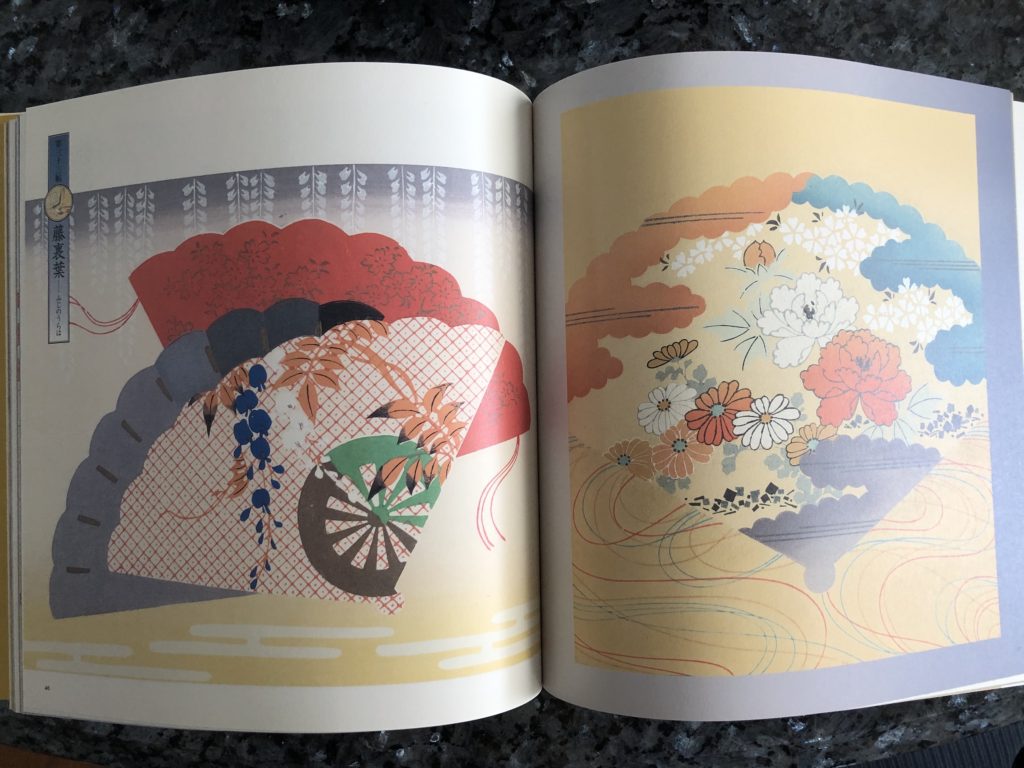
Print 33
Fans and flowers both appear fairly often in the prints, but not in the exact combination (a common refrain here). I found the flowers in Print 4 and the flower and fan combination in Print 25, Print 33, and Print 51. I didn’t see the items depicted on the fan [3].
Chapter Summaries: Chapter 4 has Genji visiting his old nursemaid. While he is in the vicinity, he stops to admire a house with Yugao (evening faces) flowers and falls in love with the woman inside. The woman is named Yugao after the flowers and she is one of To-no-Chujo’s lovers [4]. So Genji spirits her away; unfortunately, Yugao dies after her liason with Genji [5].
In Chapter 25, Genji helps Tamakazura and Prince Hotaru get together, pays a friendly visit to “the lady of the orange blossoms”, and talks about how fiction is a ‘legitimate art form’ [6]. The Chapter ends with To-no-Chujo wondering what happened to his child with Yugao.
A lot of things happen in Chapter 33 but this fan that is filled with peonies and chrysanthemums and represent spring in Genji’s world. In terms of plot, this chapter contains: To-no-Chujo and Yugiri [7] have a wisteria-viewing party, Genji and Murasaki attend the Kamo River Festival (where he remembers the “horrible quarrel” between Aoi and Rokujo), and the reigning emperor and the retired emperor Suzaku visit Genji’s palace.
Jumping ahead to Chapter 51, Niou has fallen in love with one of Kaoru’s lovers, Ukifune. As she exchanges letters and poems with both of them, Ukifune starts to fall in love with Niou as well and the stress of having to choose between both men leads her to contemplate suicide.
What this could mean: So every time we’ve seen flowers and fans in the book, there’s a romantic liaison at play (to be fair, there are a lot of affairs in this book so it’s pretty common). Still, the fact that a stylised Yugao is there makes me think that this fan and flowers is about the Yugao arc in the book. I’ve added a picture from The Reader’s Guide of The Tale of Genji where the stylised yugao flower is even closer to the style on the shirt than in the print.
Flower Shirt


Print 33 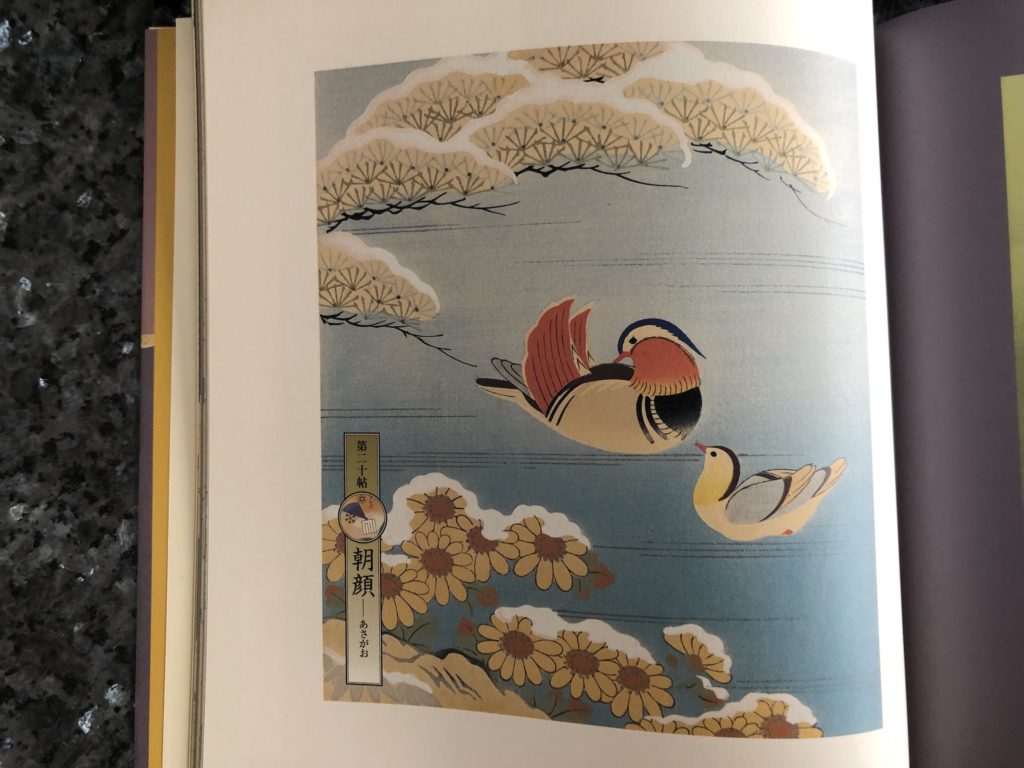
Print 20 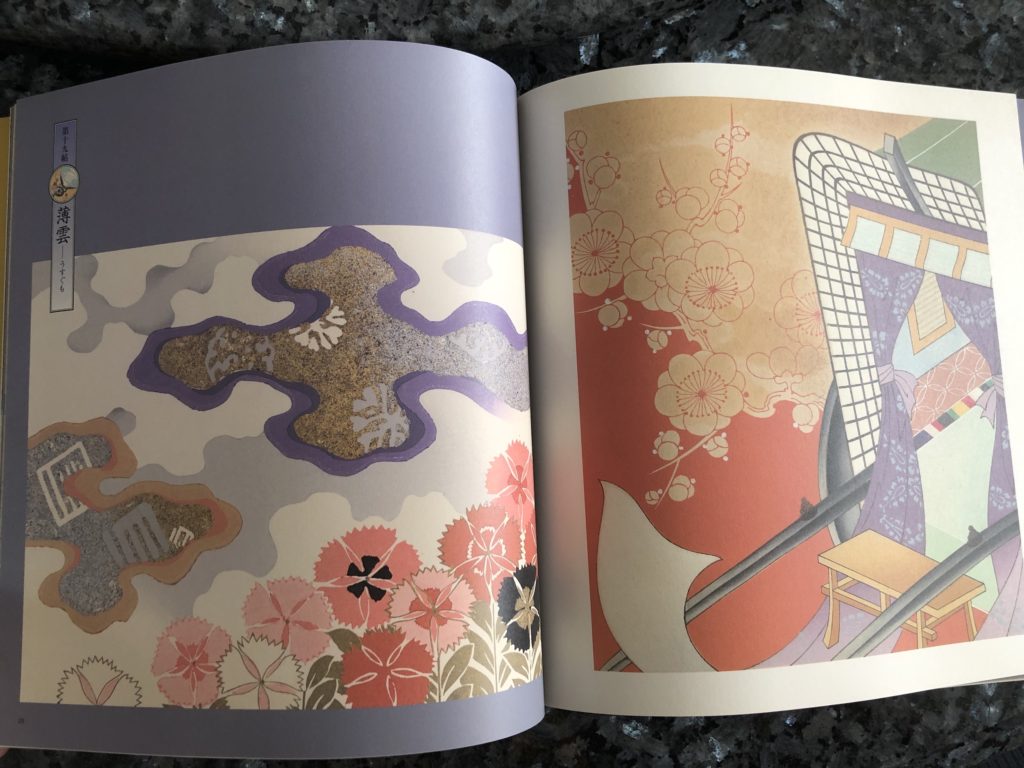
Print 19 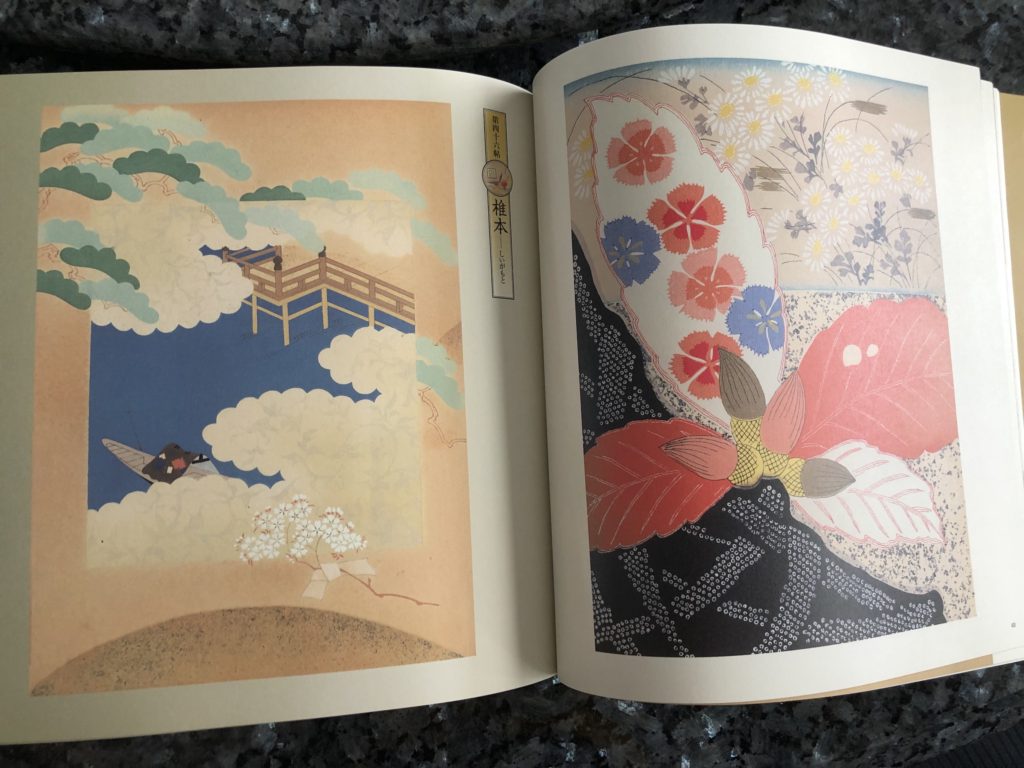
Print 46
Lots of flowers here! While I did not see the exact combination in one print, I saw similar flowers in Print 19, Print 20, Print 33, and Print 46. I could not, however, find the flowers at the bottom right (at the heart of the circle).
Chapter Summaries: In Chapter 19, Genji manages to persuade one of his lovers, the Lady of Akashi to give their daughter over to Murasaki (the little girl he kidnapped and groomed to be his main lover) to be brought up as a noble. At the same time, his wife’s father retires and Genji takes over the role of imperial advisor (to the Emperor, who’s secretly his son by the affair he had with Fujitsubo). The Emperor realises that Genji is his father and wants to abdicate in favour of him but Genji persuades him not to do so. Fujitsubo also dies in this chapter, which is a huge blow to Genji. In Chapter 20, Genji sees a chance to finally seduce an old flame but he fails. The chapter ends with him and Murasaki sharing memories of various ladies. He also dreams that Fujitsubo comes back from the dead in a dream to chastise him.
Chapter 33 has been recapped in the previous section. In Chapter 46, we’re back in the section of the book focusing on the younger generation. There is a prince of Uji who is determined to renounce the world, leaving behind his two daughters. Niou wants to chase both of them but only the older one (Agemaki) is up to the experience of exchanging letters with him. Kaoru is trying to figure out if he should become a monk (aka renounce the world as well) because he has not honoured his true father [8].
What this could mean: Again, we see that flowers and ladies are connected. No surprise because not only is nature a huge part of the book (especially the seasons), many of the ladies are identified with flower names. Perhaps this is a tribute to all the ladies in The Tale of Genji and I’m just really bad at identifying flowers?
Flowers in Vases Shirt

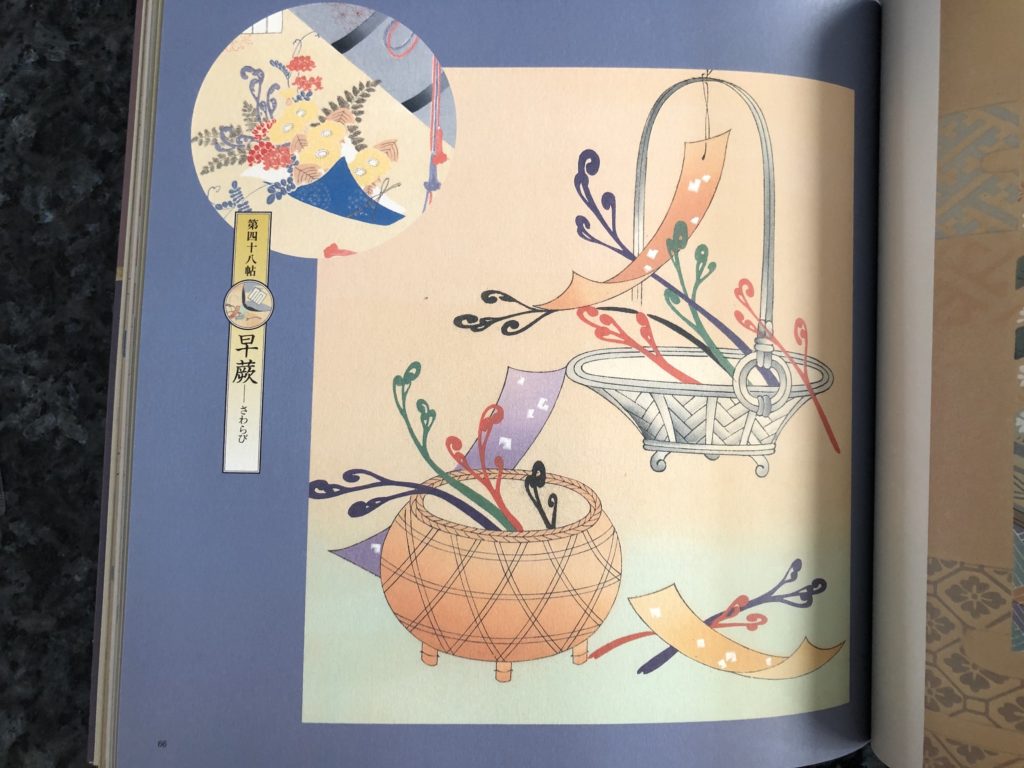
Print 48
I was wondering what the round things were and after going through the prints, I think they’re vases! I’ve only seen a round vase in Print 48.
Chapter Summary: Niou has managed to compromise the younger Uji princess (Kozeri) in the previous chapter. Kaoru fell in love with Agemaki, though he hasn’t done anything, and she also passed away in the previous chapter. In Chapter 48, Niou brings Kozeri to the capital to live with him. Yugiri wants Nious to marry his daughter but because he’s obviously not interested, he tries to get Kaoru to marry her. Kaoru is still pining for Agemaki.
What This Could Mean: Apparently the baskets here come with 「供養の初穂」written on the papers. 供養 refers to a memorial service while 初穂 refers to ripe ears of rice that are offered to the gods so I am completely stymied about what this phrase means. Google is no help but according to the book, eating this will give you a long life. There aren’t any papers or rice in the baskets on the shirt so I can only assume that they are decorations.
Wheels and Flowers Shirt


Print 19 
Print 49 
Print 9
The wheel probably represents a carriage and you can see this combination of carriage and flowers in Print 9 and Print 19. As for the leaves on the plant, I saw something similar on Print 49.
Chapter Summaries: Going back to the start of the book, in Chapter 9, Genji’s father, the Emperor, has retired. But the retired emperor still has power and even the time to rebuke Genji for his treatment of Lady Rokujo. However Lady Aoi is pregnant, and Genji has even less time for Lady Rokujo. Things come to a head at the Kamo River festival where Lady Aoi’s attempts to push her carriage to a good spot ends up insulting Lady Rokujo. After that, Aoi’s health declines as her pregnancy progresses and everyone suspects spiritual possession by Lady Rokujo. Lady Aoi dies a few days after giving birth to Yugiri and after grieving, Genji decides that Murasaki is old enough (she’d be about fifteen in this chapter) to be his wife.
Chapter 19’s been summarised already so I’ll skip on ahead to Chapter 49. In Chapter 49, Kaoru and Niou are under increasing pressure to marry but they are more concerned with their respective love affairs. Kaoru is starting to fall in love with Kozeri and to prevent this affair from developing (and to stop Niou from being jealous), Kozeri tells Kaoru about an illegitimate half-sister of hers who resembles Agemaki. This half-sister is none other than Ukifune and Kaoru immediately starts looking for her. While searching, Kaoru finally bows to pressure to marry the Second Princess (daughter of am emperor) and there’s a wisteria banquet. The chapter ends as Kaoru manages to catch a glimpse of Ukifune at Uji.
What this could mean: The wheel obviously represents a carriage. As the main mode of transport, the carriage conveys the occupant’s status and could be associated with journeys. According to the book, the plants are pine (representing Kaoru) and sakura (representing Niou). Perhaps this is about all those trips to Uji that Kaoru and Niou both make. I know that the carriages appeared in the earlier sections but as the plants are tied to Niou and Kaoru in Print 49, I think that this print would be more about these two rather than Genji and his many love affairs.
Conclusion
I’m not going to lie, I started this post hoping to be able to find clear motifs that I could connect to particular characters or themes, especially since many of these prints are about nature, many people are given nature-related names in the translations, and because “sensitivity to the subtle moods of nature, indeed, was an essential attribute of ‘good people’.” [9] But perhaps because nature was such a pervasive part of their life, there isn’t one clear meaning for each symbol. Instead, the artist seems to have created prints that evoke the sense of chapter and reused flowers as it made sense within that particular context.
I may not have been successful in decoding the meaning behind these shirts, but I hope that you’re a bit more interested in The Tale of Genji. It’s been influencing readers for centuries and is definitely still worth a read in this day and age.
If you’re interested in the prints featured in this book, definitely get a copy of 河原崎奨堂 源氏模様. If you’re out of Japan, you can grab a copy via Amazon Japan. If you’re in Japan, you can grab a copy from Unsodo’s site. The prints are truly lovely and you don’t need to know Japanese to appreciate them.
Further Reading
If you think that The Tale of Genji sounds very complicated and dramatic, it’s basically a very long drama. Here’s my review of the unabridged book, if you’re thinking of reading it. I’d also recommend having The Reader’s Guide by William J. Puette with you to keep track of what’s going on.
For an introduction to the world of Heian Japan, I’d recommend The World of the Shining Prince by Ivan Morris and the other posts in my World of Genji series.
Notes
[1] Apart from them sampling from the prints, I don’t think this book contains all Genji prints ever made by Unsodo. It’s possible (and probable) that the Uniqlo designers drew reference from prints not in this book.
[2] Kaoru literally has a fragrance emitting from his body (so no B.O, I guess) while Niou, not to be outdone, scents his robes.
[3] Fans were popular in Japan, so much that the laws were passed to restrict their usage to certain social classes. It’s thought that painted fans began in the Heian-era, during Genji’s time and you can read a little more about them here and here.
[4] To-no-Chujo is the brother of Lady Aoi, Genji’s official wife and hence Genji’s brother-in-law.
[5] It is implied that the jealous Lady Rokujo is the cause of her death. Lady Rokujo is also thought to be the cause of Lady Aoi’s death through her jealous feelings.
[6] Quoting from The Tale of Genji: A Reader’s Guide by William J. Puette
[7] Yugiri is Genji’s first son by his wife Lady Aoi. Lady Aoi sickens and dies after giving birth to him.
[8] Basically, they have an ‘affair’ but in reality Kashiwagi rapes her and she gets pregnant from it.
[9] Quoting The World of the Shining Prince by Ivan Morris

